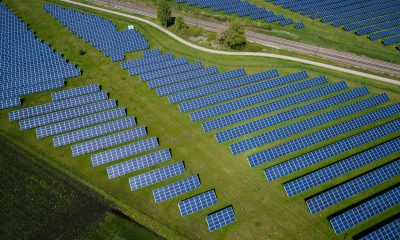Impact Investing
Cerved: 540 Italian SMEs Operate in Sectors Exposed to the Energy Transition
The Italian productive sector, despite recent economic challenges, remains robust, with over 1,100 companies capable of issuing minibonds up to €15 billion. Almost half of these could be “green” bonds, supporting sustainability policies, with an emission potential of €6.6 billion. Cerved Rating Agency identifies these opportunities, emphasizing the importance of minibonds in diversifying financing sources for SMEs.

Despite the undeniable economic and financial shocks to which it has been subjected in recent years, the Italian productive fabric is healthy, with over 1,100 companies that could issue up to 15 billion euros in minibonds without weakening their economic-financial structure, according to Cerved.
Of these, almost half could be “green” in support of sustainability policies: 6.6 billion in mini green bonds, thanks to 540 possible issuers operating in the sectors most exposed to the ecological and energy transition.
That is stated by Cerved Rating Agency, the Italian rating agency specialized in assessing the creditworthiness of companies and measuring ESG performance, which, starting from the over 15 thousand non-financial companies subject to its assessment, has identified a representative sample of the Italian economy in terms of sectors, geographical distribution, size, legal form and financial structure.
“In a credit market dominated by banking offerings – explained Fabrizio Negri, CEO of Cerved Rating Agency – minibonds are an excellent opportunity, because they offer issuing SMEs an additional or alternative financing instrument and an interesting choice for stakeholders of investment towards private companies. Furthermore, the growing focus on sustainability has also had tangible effects on the minibond market, which is becoming an important additional source for supporting the competitiveness of SMEs.”
Minibonds are debt securities typically issued by small and medium-sized businesses to diversify sources of financing and access the professional investor market.
The investigation by Cerved into the potential for issuing minibonds
For the purposes of the investigation, CRA selected from the sample only non-financial companies with revenues between 5 and 500 million euros, to which strict financial criteria were then applied in order to obtain subjects capable of issuing minibonds without jeopardizing the own economic-financial balance.
This led to a shortlist of 1,133 companies, 75% of which are located in Northern Italy, which could issue minibonds for 15.2 billion euros with a maximum limit of 50 million euros each.
At a geographical level, we find the North-West in the lead with 483 companies and an emission potential of 7.1 billion euros, followed by the North-East (369 companies and 5.1 billion), the Center (151 and 1.9 billion) and from the South and Islands (130 and 1.1 billion).
81% of these are companies with a turnover of between 50 and 500 million euros, but the share of small businesses is also significant (19%). As regards macro-sectors, manufacturing companies stand out (69%), followed by services (11.6%) and trade (8.5%).
Regional data from Cerved survey
Going into the detail of the individual regions, Lombardy leads the minibond ranking, with 312 possible issuing companies and 5.06 billion euros of potential: a subset of 146 could then issue mini green bonds, for an equivalent value of 2, 16 billion.
Also on the podium we find Veneto, with 180 companies for 2 billion in potential emissions (100 and 1.11 billion if the green focus is considered) and Piedmont, with 144 companies for 1.7 billion (77 and 0.76 billion) , followed by number of companies (136) by Emilia Romagna, which however comes second, with 2.31 billion, for possible emissions, of which 0.73 are green (50 issuers).
All the other regions record significantly lower numbers, below 50 units (except Tuscany): Molise and Calabria close the ranking, with only one possible broadcaster each, while things are slightly better for Sardinia, Valle d’Aosta and Basilicata , which reaches 4.
I mini green bond
Cerved Rating Agency then dedicated a focus to mini green bonds, issued by companies that belong to the sectors most exposed to the ecological and energy transition, such as construction, automotive, manufacturing activities, electricity, gas and water supply, waste management, transport and warehousing, information and communication services, real estate activities, agriculture, steel, chemicals, plastics and rubber, machinery manufacturing.
This is a substantial subset of the 1,133 initial companies, i.e. 540 companies, with an emissions potential of 6.6 billion euros.
At a geographical level, the distribution is similar to that of “traditional” minibonds.
The North-West boasts 238 companies and an emission potential of 3.2 billion euros, followed by the North-East (175 companies and 2.1 billion euros), the Center (71 and 0.8 billion) and the South and Islands (56 and 0.4 billion).
75.7% of these are companies with a turnover between 50 and 500 million euros, but the share of small businesses is also significant (24.3%).
As regards the macro-sectors, manufacturing activities stand out (69.3%) linked to the sustainable transition, followed by companies operating in the green construction and real estate sector (11.3%) and services (10.4%).
Lower risk levels than average
Finally, thanks to the historical depth of Cerved Rating Agency’s credit ratings, it was possible to monitor the evolution of the average probability of default from 2014 to 2024 for all the companies examined.
The analysis highlighted how the possible issuers of minibonds, including mini green bonds, present lower risk levels and less evident variations in probability of default compared to the overall sample of companies rated by the CRA.
In the decade considered, in fact, the average PD remains steadily below 2%, with low percentage variations and substantially decreasing, compared to the entire sample which never fell below 4.47% and in March 2024 reached a peak of 6.26%.
Even evaluating the last few years, in which the overall risk levels have been more subject to fluctuations and increases, the creditworthiness of the target issuers (green and total) has remained stably high.
__
(Featured image by Mathieu Stern via Unsplash)
DISCLAIMER: This article was written by a third party contributor and does not reflect the opinion of Born2Invest, its management, staff or its associates. Please review our disclaimer for more information.
This article may include forward-looking statements. These forward-looking statements generally are identified by the words “believe,” “project,” “estimate,” “become,” “plan,” “will,” and similar expressions. These forward-looking statements involve known and unknown risks as well as uncertainties, including those discussed in the following cautionary statements and elsewhere in this article and on this site. Although the Company may believe that its expectations are based on reasonable assumptions, the actual results that the Company may achieve may differ materially from any forward-looking statements, which reflect the opinions of the management of the Company only as of the date hereof. Additionally, please make sure to read these important disclosures.
First published in Crowdfunding buzz. A third-party contributor translated and adapted the article from the original. In case of discrepancy, the original will prevail.
Although we made reasonable efforts to provide accurate translations, some parts may be incorrect. Born2Invest assumes no responsibility for errors, omissions or ambiguities in the translations provided on this website. Any person or entity relying on translated content does so at their own risk. Born2Invest is not responsible for losses caused by such reliance on the accuracy or reliability of translated information. If you wish to report an error or inaccuracy in the translation, we encourage you to contact us

-

 Biotech2 weeks ago
Biotech2 weeks agoDiscovery of ACBP Molecule Sheds Light on Fat-Burning Tissue Suppression and Metabolic Disease
-

 Impact Investing6 days ago
Impact Investing6 days agoFrance’s Nuclear Waste Dilemma Threatens Energy Future
-

 Markets2 weeks ago
Markets2 weeks agoGlobal Sugar Market Sees Mixed Trends Amid Weather Shifts and Price Pressures
-

 Fintech3 days ago
Fintech3 days agoKraken Launches Krak: A Game-Changing Peer-to-Peer Crypto Payment App

























